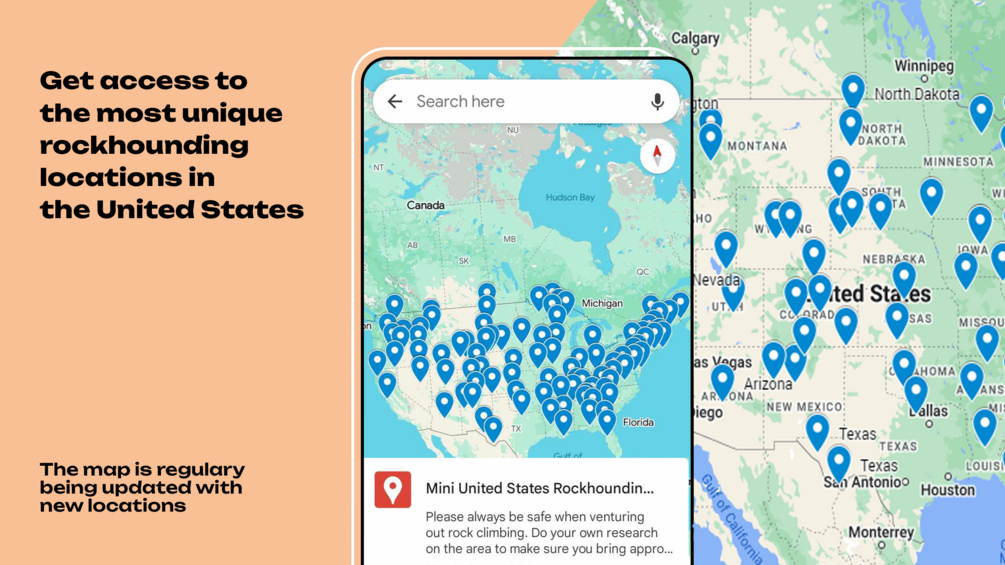Vermont’s picturesque landscapes aren’t just a feast for the eyes; they’re also a treasure trove for rockhounds like you.
With its rich geological history, the Green Mountain State offers a unique playground for anyone eager to unearth hidden gems.
Rockhounding in Vermont unveils treasures like garnets in the Green Mountains and quartz crystals in Chester. Explore the Champlain Valley for fossils, Rock River for diverse minerals, and Bethel Quarry for beryl. Always seek permission for private land access and respect local rockhounding laws.
Get our FREE United States Rockhounding Map HERE

Vermont Rockhounding Locations
Embarking on a rockhounding adventure in Vermont offers a variety of locations, each with its own unique set of treasures. When you’re ready to explore, the Green Mountain State has several prime spots you should consider.
The Champlain Valley, a haven for fossil enthusiasts, is where you can uncover ancient marine fossils like gastropods and trilobites. The vast area’s rock layers are rich in history, dating back over 450 million years, providing a literal ground for historical exploration.
Heading southeast, the Rock River in Newfane draws gem hunters with the promise of diverse minerals. It’s particularly known for its garnets, a deep red gemstone that’s both beautiful and plentiful.
- Chester, known for its abundance of quartz crystals, offers sites where even beginners can strike it lucky.
- The picturesque town of Lowell houses the treasure trove of the Eden Mills quarries where stunning green vesuvianite and grossular garnet are ripe for the picking.
For a touch of historical pizzazz, the Ruggles Mine in nearby Grafton welcomes visitors to dig through piles of discarded mica, beryl, and amethyst. Though the mine is no longer in operation, the residual minerals provide plenty of opportunities for rockhounds.
Lastly, Bethel Quarry tantalizes with its well-known beryl and mica deposits. It’s a favorite among rockhounds for its easy access and generous mineral offerings.
While Vermont may seem peaceful and serene, beneath its surface lies a world of geological wonders waiting to be discovered. Whether you’re a seasoned collector or just starting out, Vermont’s rockhounding locations offer an adventure that combines natural beauty with the thrill of finding your own piece of the Earth’s heritage. Remember, always ensure you have permission to collect on private land, and heed local guidelines for sustainable collecting practices to keep these sites accessible for everyone.
What Gemstones are Found in Vermont?

If you’re an avid rockhound, Vermont’s diverse geology won’t disappoint. From dazzling garnets to shimmering quartz, the Green Mountain State’s terrain is a treasury of gemstones waiting to be discovered by enthusiasts like you.
Garnets, a symbol of passion and love, are probably the most prestigious stones you can unearth in Vermont. Locations like the Green Mountains are known as a haven for this fiery red stone, commonly found alongside stunning green vesuvianite. The array of garnets available in Vermont is not limited to one variety; here, almandine and grossular garnets are waiting to be plucked from the earth.
Quartz is another gemstone that Vermont is rich in, offering variations like smoky quartz, rose quartz, and clear quartz. In Chester, the chances are high that you’ll stumble upon impressive quartz crystals that reflect light like tiny prisms.
Amongst the many appealing treasures, beryl stands out with its distinguishing green hues. This mineral, which includes precious emeralds and aquamarines in its family, can be uncovered in areas like the Bethel Quarry. Finding a piece of beryl could mean stumbling upon anything from pale green stones to richer, blue-tinged specimens.
Don’t overlook mica, which often occurs in sheets that gleam with a unique pearly luster. While not traditionally viewed as a gemstone like diamonds or rubies, mica’s distinctive appearance makes it a prized find among collectors. For rockhounds with a taste for the unusual, Vermont’s geological recipe doesn’t fall short—a treasure trove of eye-catching minerals are spread throughout the state.
When you’re navigating the various rockhounding locales, keep in mind the characteristics of these gemstones. Familiarize yourself with their typical formations, colors, and hardness, ensuring that when you’re sifting through the dirt and stone, you’ll recognize the gems that lie beneath.
What Sedimentary Rocks You Can Find in Vermont?

While Vermont is famed for its stunning gemstones, it’s also a treasure trove for sedimentary rock enthusiasts. As you comb the Green Mountains, you’ll discover a wealth of sedimentary formations. Notably, the Champlain Valley is a sedimentary basin that was once the bed of the Champlain Sea. Here, you can find layers of shale, limestone, and sandstone, each telling a story of the land’s distant past.
Among the sedimentary rocks, dolostone and limestone are prevalent, with dolostone featuring prominently in the Isle La Motte region. This rock is historically significant as it houses some of the world’s oldest coral reefs. In your search, you might also encounter slate in the Slate Valley, a material widely used in construction and renowned for its durability.
- Shale
- Limestone
- Sandstone
- Dolostone
- Slate
These sedimentary rocks are more than just visually appealing; they offer a glimpse into the Earth’s geological history. Limestone, in particular, commonly bears fossils of ancient marine life that once thrived in prehistoric seas. You might find imprints of trilobites, brachiopods, or other creatures embedded within these stones.
Vermont’s sedimentary rock layers are also significant for their mineral deposits, often including beautiful calcite crystals and other mineral specimens. While the gleam of quartz or the allure of beryl may capture your attention, don’t overlook the subtle beauty found in sedimentary rocks. Be sure to respect any private property or protected areas while exploring, and always seek permission where necessary. Your next rockhounding trip could yield not only beautiful stones but also an educational journey through the eons.
What Metamorphic Rocks are found in Vermont?
Vermont is a haven for rock enthusiasts and geologists alike, particularly due to its rich presence of metamorphic rocks. As you delve into the state’s rocky terrain, you’ll be met with fascinating examples of how heat, pressure, and chemical processes transform rocks from one type to another.
Marble stands out amongst the most prominent metamorphic rocks in Vermont. Originating from limestone, it’s primarily found in the Danby-Mount Tabor area—the location of the world’s largest underground marble quarry. Danby marble is renowned for its high quality and has been used in both construction and art.
Schist is another metamorphic rock commonly encountered in Vermont. Characterized by its flaky layers and ease of splitting into thin sheets, schist is formed from mudstone and shale. Glistening with minerals like mica, garnet, and staurolite, it’s not just an object of scientific curiosity but also a collector’s joy. The Green Mountains are known for their schist deposits, offering rockhounds a chance to uncover pieces with unique mineral assemblages.
Then there’s gneiss, a prominently banded rock that’s the result of high-grade metamorphism. Gneiss can be found across Vermont, with intricate patterns that make each specimen stand out. Whether it’s the classic banding or the occasional presence of vibrant garnet crystals, gneiss is a testament to the dynamic geological forces at play over millions of years.
Quartzite, a rock known for its hardness and resistance to weathering, is also present in Vermont. It starts its journey as sandstone before metamorphosing into the durable rock that rockhounds prize. Quartizite’s presence is noticeable around the Green Mountain area, with its pure varieties being highly sought after for both practical and aesthetic purposes.
In exploring the rich tapestry of Vermont’s geology, you’ll uncover the stories these rocks tell of the Earth’s evolving landscape. The fascinating part of rockhounding here is not just what you find, but also the insights into the planet’s history that come with each discovery.
What Igneous Rocks can You Find in Vermont?
Vermont isn’t just a haven for metamorphic rock collectors; it’s also where igneous rocks make an intriguing appearance. You might be surprised to find that the Green Mountain State has basalt and granite, two of the most well-known igneous rocks, scattered throughout its terrain.
When exploring the regions known for their igneous deposits, you’ll encounter basalt—formed from the rapid cooling of lava at Earth’s surface. Often dark in color and fine-grained, basalt in Vermont is a testament to the state’s ancient volcanic activity. You’ll find excellent specimens in areas where volcanic activity was once prevalent, such as the hills near Lake Champlain.
Granite, the cornerstone of continental crust, boasts a more complex story in Vermont. This intrusive igneous rock, characterized by its coarse grains and durability, can be found in the core of the Green Mountains. With colors ranging from pink to gray, Vermont’s granite is sought after not just by rockhounds but also by industry professionals for its beauty and strength.
- Isle La Motte: Renowned for its basalt deposits, this island on Lake Champlain offers a true glimpse into Vermont’s volcanic past.
- Graniteville: This aptly named community is part of Barre, which is famous for its high-quality granite quarries.
Whether you’re collecting samples or simply appreciating the natural artistry, understanding the origins of Vermont’s igneous rocks adds an extra layer to your rockhounding journey. Pinpointing the right spots, equipped with this knowledge, can lead to unforgettable discoveries as you delve into the state’s igneous rock formations. Keep in mind that some areas may require permission to collect, so always ensure you’re rockhounding responsibly and within legal boundaries.
Panning for Gold in Vermont
If you’re intrigued by the possibility of discovering gold, Vermont provides several locations where you can pan for this precious metal. Gold panning in Vermont has a rich history, dating back to the first discoveries in the nineteenth century. Today, amateur geologists and hobbyists alike can enjoy the thrill of the hunt in the Green Mountain State’s streams and rivers.
The Buffalo Brook in Plymouth, Vermont, is a well-known spot for gold panning. It garners attention due to the Buffalo Brook’s historic association with the Plymouth Five Corners gold rush in the 1850s. Here, the waters have washed down flakes and small nuggets over the centuries, leaving behind placer gold for you to discover. Clear, shallow areas in the brook make for ideal panning locations.
Another hotspot is Broad Brook near Bridgewater. It’s part of the Ottauquechee River system and is easily accessible for those looking to sift through its sandy beds. Your chances of finding small quantities of gold are quite good, especially after heavy rains that churn up the riverbed materials.
| Gold Panning Locations in Vermont | Accessibility | Historical Significance |
|---|---|---|
| Buffalo Brook, Plymouth | High | 19th Century Gold Rush |
| Broad Brook, Bridgewater | Medium | Part of Ottauquechee |
As you gear up for your gold panning adventure, keep in mind that gentle techniques and patience are key. Gold is heavier than most other materials you’ll find in the stream bed, so it tends to settle at the bottom. Use a shaker motion to bring the heavier elements to the pan’s edge. Additionally, be sure to check local guidelines and regulations; some areas require a permit for panning.
Bring along a set of simple tools—a pan, a sieve, and a small shovel. It’s also a good idea to wear waterproof boots and bring along a sturdy bag for your finds. Whether you’re searching for little flakes or the rare larger nugget, gold panning in Vermont is a rewarding experience that connects you with the state’s geological history.
By familiarizing yourself with the regions known for their gold deposits, you enhance your rockhounding journey through Vermont. Keep in mind that gold panning is often about the experience and the beauty of Vermont’s natural environment as much as it is about the potential finds.
Rocks and Minerals Found in Vermont
Vermont is a treasure trove of geological wonders. As you explore the quaint countryside and lush hills, you’ll discover an array of rocks and minerals that are as diverse as they are captivating.
Garnet, a deep red gemstone known for its hardness and use in jewelry, is prevalent in the Green Mountains. You’ll find this durable gem principally in the form of almandine, which can be spotted in mica schists and gneiss.
In addition to garnet, Vermont is home to talc, one of the softest minerals on Earth. This mineral is primarily sourced in the southwest regions of the state, where it has been mined for over a century. Talc from these deposits is famed for its high quality and is used in a variety of products, from paper to cosmetics.
Here’s a quick list of other notable minerals you can find:
- Quartz, in its many forms, including amethyst, smoky quartz, and milky quartz
- Beryl, with aquamarine being a sought after variety found in the mica schists
- Asbestos, particularly chrysotile, which should be handled with caution due to its health hazards
For those interested in fossilized remains, marble deposits in Vermont have preserved an impressive array of ancient life, from small sea creatures to large plant fossils. These snapshots of prehistoric ecosystems provide not only a hunting ground for rockhounders but also a glimpse into Earth’s distant past.
The diversity in Vermont’s geology also includes the presence of copper and lead ores. Although not as commonly sought after by casual rockhounders, seasoned collectors might find these metallic deposits particularly interesting.
Each rock and mineral has its own set of challenges to find and identify, but the pursuit often leads to rewarding discoveries. As you gear up for your rockhounding adventure, remember to respect landowner rights and the environment, ensuring these treasures can be pursued for generations to come.
Where Can I Find Fossils in Vermont?
Delving into Vermont’s earth not only yields an array of crystals and minerals but also offers a precious peek into ancient life. Fossils, the preserved remains or traces of organisms, are scattered throughout Vermont’s geologic tableau. When you’re on the hunt for these natural time capsules, knowledge of specific locales can drastically elevate your chances of success.
The Champlain Valley, particularly around the town of Isle La Motte, is famed for its fossilized reef structures. Here, the Chazy Reef, over 450 million years old, reveals a trove of ancient marine life. As you navigate this region, you might uncover fossils of trilobites, ancient cephalopods, and other sea creatures that once thrived in a long-vanished ocean.
Another noteworthy locale is the Lake Champlain area, where you can find Middle Ordovician fossils. These remnants of an even earlier epoch are evidence of Vermont’s dynamic earth movements. While searching shores and exposed rock formations, keep an eye out for gastropods and brachiopods that rest within the archaic stones.
Your rockhounding adventure might also lead you to south-central Vermont, particularly near Ludlow. This region hosts various marble quarries and limestone formations. Within these carbonate-rich stones, you are likely to spot fossilized remnants of coral, crinoids, and even rare trilobite impressions.
To optimize your fossicking efforts in Vermont, adhere to a few key practices:
- Always secure permission before entering private land to rockhound.
- Utilize proper tools like hammers, chisels, and brushes to gently extract specimens.
- Be mindful of conservation laws to protect the state’s rich geological heritage.
Remember, fossil hunting is as much about enjoying Vermont’s natural beauty as it is about the thrill of discovery. Equip yourself with patience, a sharp eye, and respect for the terrain, and your expeditions may yield a captivating connection to the distant past.
Vermont Rockhounding Laws & Regulations
When you’re rockhounding in Vermont, knowing the local laws and regulations is crucial for a legal and enjoyable experience. The state places a strong emphasis on landowner rights and environmental conservation. Before you set out on your adventure, ensure you have explicit permission from landowners when accessing private property.
Public Lands can be more accessible for rockhounding activities; however, they also come with rules to preserve natural heritage. It’s important to familiarize yourself with the guidelines set forth by the Vermont Agency of Natural Resources. Taking anything from state parks and forests without a permit is illegal and can result in substantial fines.
State regulations typically allow for casual collection of rocks and minerals for personal use, which means:
- Anything collected should not be for commercial or trading purposes.
- Collecting is generally limited to surface materials without the use of mechanical equipment.
- There are quantity restrictions, ensuring you don’t take more than is reasonable for a hobbyist.
If you’re hoping to explore federally-managed lands, like national forests, different rules apply. The US Forest Service requires those wishing to remove geological materials to obtain a free use permit. These are generally granted for small quantities and, similar to state rules, don’t allow for commercial resale.
In addition to these overarching guidelines, individual towns or counties might have their own ordinances. Always check with local authorities before you pick up that first rock or fossil.
As a responsible rockhound, you’ll also want to follow the Code of Ethics provided by the American Federation of Mineralogical Societies:
- Respect all property and land, public and private.
- Leave no trace and take only what you need.
- Do not destroy wildlife or vegetation.
Adhering to these practices ensures the preservation of Vermont’s geological wonders for future generations and maintains the integrity of the hobby. Remember to tread lightly and act thoughtfully as you explore Vermont’s rich geological landscape.
Rockhounding Tips for Beginners in Vermont
Gearing Up: Essential Tools for Rockhounding
Starting on the right foot in rockhounding means having the right gear. Here’s what you’ll need:
- Geologist’s hammer or rock pick: Ideal for chipping away at specimens
- Sturdy gloves: To protect your hands from sharp edges
- Safety goggles: Essential for eye protection against flying rock chips
- Durable backpack: To carry your finds and tools
- Field guide: To identify rocks, minerals, and fossils
- Collection bags or containers: For organizing and transporting your specimens
Remember, quality tools can make a significant difference in your rockhounding experience. Investing in good equipment ensures safety and efficiency while exploring Vermont’s treasured geology.
Safety Tips While Rockhounding
Safety should always be your top priority. Here are key tips to keep in mind:
- Stay aware of your surroundings; steep cliffs and loose rocks can present real dangers
- Always inform someone of your location and planned return time
- Dress appropriately for the weather and rugged terrain: think boots and layers
- Keep a first-aid kit on hand for emergencies
- Hydrate regularly, and pack enough water, especially during hot summer months
- Pay attention to signs of wildlife and know how to respond safely
Safety isn’t just about preparation, it’s about ongoing vigilance while you enjoy Vermont’s natural landscapes.
Legal Guidelines for Rockhounding Enthusiasts
Understanding and adhering to legal guidelines is crucial for rockhounding in Vermont. Here’s what you need to know:
- Always obtain permission from landowners before entering private property
- Research any local ordinances that may apply to rockhounding activities
- State parks and forests may require permits for collection; check with the Vermont Agency of Natural Resources
- Federal lands managed by the US Forest Service have their own set of rules—compliance is mandatory
- Adhere to the American Federation of Mineralogical Societies’ Code of Ethics to preserve sites for future generations
Respecting these legalities not only protects Vermont’s geological heritage but also ensures that rockhounding remains an enjoyable and accessible hobby for all.
Conclusion: Vermont Rockhounding Guide & Map
Embarking on a rockhounding adventure in Vermont offers a unique opportunity to uncover treasures from the Earth’s rich history.
Whether you’re drawn to the garnet-laden Green Mountains or searching for fossilized marvels in the Champlain Valley, you’ll find that each location provides a distinct experience. Remember to always seek permission, come prepared with the right tools, and adhere to the guidelines that protect these natural wonders. Your respect for the environment and adherence to rockhounding ethics ensure that these treasures can be enjoyed for generations to come.
Happy hunting!







